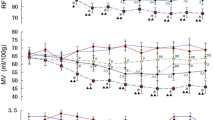Abstract
Obstructive sleep apnoea is characterized by chronic intermittent hypoxia (CIH) due to recurrent apnoea. We have developed a rat model of CIH, which shows evidence of impaired respiratory muscle function. In this study, we wished to characterize the ventilatory effects of CIH in conscious male and female animals. Adult male (n=14) and female (n=8) Wistar rats were used. Animals were placed in chambers daily for 8 h with free access to food and water. The gas supply to one half of the chambers alternated between air and nitrogen every 90 s, for 8 h per day, reducing ambient oxygen concentration in the chambers to 5% at the nadir (intermittent hypoxia; n=7 male, n=4 female). Air supplying the other chambers was switched every 90 s to air from a separate source, at the same flow rates, and animals in these chambers served as controls (n=7 male, n=4 female). Ventilatory measurements were made in conscious animals (typically sleeping) after 10 days using whole-body plethysmography. Normoxic ventilation was increased in both male and female CIH-treated rats compared to controls but this did not achieve statistical significance. However, ventilatory drive was increased in CIH-treated rats of both sexes as evidenced by significant increases in mean and peak inspiratory flow. Ventilatory responses to acute hypoxia (FIO2 = 0.10; 6 min) and hyperoxic hypercapnia (FICO2 = 0.05; 6 min) were unaffected by CIH treatment in male and female rats (P>0.05, ANOVA). We conclude that CIH increases respiratory drive in adult rats. We speculate that this represents a form of neural plasticity that may compensate for respiratory muscle impairment that occurs in this animal model.
Access this chapter
Tax calculation will be finalised at checkout
Purchases are for personal use only
Preview
Unable to display preview. Download preview PDF.
Similar content being viewed by others
References
Behan, M., Zabka, A.G., Thomas, C.F., Mitchell, G.S. 2003, Sex steroid hormones and the neural control of breathing, Respir Physiol Neurobiol 136: 249–63.
Bradford, A., McGuire, M., O’Halloran, K.D. 2005, Does episodic hypoxia affect upper airway dilator muscle function? Implications for the pathophysiology of obstructive sleep apnoea, Respir Physiol Neurobiol 147: 223–34.
Dunleavy, M., Bradford, A., O’Halloran, K.D. 2008, Oxidative stress impairs upper airway muscle endurance in an animal model of sleep-disordered breathing, Adv Exp Med Biol 605: 458–62.
Julien, C., Bairam, A., Joseph, V. 2008, Chronic intermittent hypoxia reduces ventilatory long-term facilitation and enhances apnea frequency in newborn rats, Am J Physiol Regul Integr Comp Physiol 294: R1356–66.
Katayama, K., Smith, C.A., Henderson, K.S., Dempsey, J.A. 2007, Chronic intermittent hypoxia increases the CO2 reserve in sleeping dogs, J Appl Physiol 103: 1942–9.
McGuire, M., Zhang, Y., White, D.P., Ling, L. 2003, Chronic intermittent hypoxia enhances ventilatory long-term facilitation in awake rats, J Appl Physiol 95: 1499–508.
O’Halloran, K.D., McGuire, M., O’Hare, T., Bradford, A. 2002, Chronic intermittent asphyxia impairs rat upper airway muscle responses to acute hypoxia and asphyxia, Chest 122: 269–75.
O’Halloran, K.D., McGuire M, Bradford, A. 2007, Respiratory plasticity following chronic intermittent hypercapnic hypoxia in conscious rats. In Proceedings of the Joint Meeting of the Slovak Physiological Society, the Physiological Society and the Federation of European Physiological Societies, ed. V Strbak, Medimond S. r. l., Italy, pp.99–103.
Pawar, A., Peng, Y.J., Jacono, F.J., Prabhakar, N.R. 2008, Comparative analysis of neonatal and adult rat carotid body responses to chronic intermittent hypoxia, J Appl Physiol 104: 1287–94.
Peng, Y.J., Overholt, J.L., Kline, D., Kumar, G.K., Prabhakar, N.R. 2003, Induction of sensory long-term facilitation in the carotid body by intermittent hypoxia: implications for recurrent apneas, Proc Natl Acad Sci USA 100: 10073–8.
Peng, Y.J., Rennison, J., Prabhakar, N.R. 2004, Intermittent hypoxia augments carotid body and ventilatory response to hypoxia in neonatal rat pups, J Appl Physiol 97: 2020–5.
Ray, A.D., Magalang, U.J., Michlin, C.P., Ogasa, T., Krasney, J.A., Gosselin, L.E., Farkas, G.A. 2007, Intermittent hypoxia reduces upper airway stability in lean but not obese Zucker rats, Am J Physiol Regul Integr Comp Physiol 293: R372–8.
Rey, S., Del Rio, R., Alcayaga, J., Iturriaga, R. 2004, Chronic intermittent hypoxia enhances cat chemosensory and ventilatory responses to hypoxia, J Physiol 560: 577–86.
Reeves, S.R., Gozal, D. 2004, Platelet-activating factor receptor modulates respiratory adaptation to long-term intermittent hypoxia in mice, Am J Physiol Regul Integr Comp Physiol 287: R369–74.
Reeves S.R., Gozal, D. 2006, Changes in ventilatory adaptations associated with long-term intermittent hypoxia across the age spectrum in the rat, Respir Physiol Neurobiol 150:135–43.
Reeves S.R., Gozal E., Guo S.Z., Sachleben, L.R. Jr, Brittian K.R., Lipton A.J., Gozal D. 2003, Effect of long-term intermittent and sustained hypoxia on hypoxic ventilatory and metabolic responses in the adult rat. J Appl Physiol. 95: 1767–74.
Reeves, S.R., Guo, S.Z., Brittain K.R., Row, B.W., Gozal, D. 2006a, Anatomical changes in selected cardio-respiratory brainstem nuclei following early post-natal chronic intermittent hypoxia, Neurosci Lett 402: 233–7.
Reeves, S.R., Mitchell, G.S., Gozal, D. 2006b, Early postnatal chronic intermittent hypoxia modifies hypoxic respiratory responses and long-term phrenic facilitation in adult rats, Am J Physiol Regul Integr Comp Physiol 290: R1664–71.
Skelly, J.R., Bradford A., O’Halloran, K.D. 2008, Tempol, a SOD-mimetic, improves muscle function in a rat model of sleep apnoea, Proc Physiol Soc, in press.
Veasey, S.C., Zhan, G., Fenik, P., Pratico, D. 2004, Long-term intermittent hypoxia: reduced excitatory hypoglossal nerve output, Am J Respir Crit Care Med 170: 665–72.
Waters, K.A. and Tinworth, K.D. 2001, Depression of ventilatory responses after daily, cyclic hypercapnic hypoxia in piglets, J Appl Physiol 90: 1065–73.
Author information
Authors and Affiliations
Corresponding author
Editor information
Editors and Affiliations
Rights and permissions
Copyright information
© 2009 Springer Science+Business Media B.V.
About this chapter
Cite this chapter
Edge, D., Skelly, J., Bradford, A., O’Halloran, K. (2009). Ventilatory Drive Is Enhanced in Male and Female Rats Following Chronic Intermittent Hypoxia. In: Gonzalez, C., Nurse, C.A., Peers, C. (eds) Arterial Chemoreceptors. Advances in Experimental Medicine and Biology, vol 648. Springer, Dordrecht. https://doi.org/10.1007/978-90-481-2259-2_38
Download citation
DOI: https://doi.org/10.1007/978-90-481-2259-2_38
Publisher Name: Springer, Dordrecht
Print ISBN: 978-90-481-2258-5
Online ISBN: 978-90-481-2259-2
eBook Packages: Biomedical and Life SciencesBiomedical and Life Sciences (R0)




